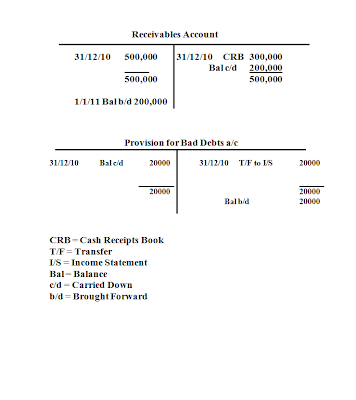What is an accrual?
This is adding together certain
items related to the business that will have to be paid out or received after a
period of time. There are two types of accruals. Accrued expense and accrued revenue.
Accrued revenue is an asset, while an accrued expense is a liability.
Where are they put into the
accounts?
They are but into the income
statement as an expense and a balance sheet as a current liability.
Prepayments
What is a prepayment?
They are expenses that have been
paid in advance but have not received the benefits of the expense. They are
seen as a current asset.
Where are they put into the
accounts?
They are but into the income
statement as an income and a balance sheet as a current asset.
Click on this link to learn more about accruals and prepayments:
Depreciation
What is deprecation?
To see a definition of depreciation check out the page on
deprecation
http://irish21stcenturystudents.blogspot.ie/2012/07/depreciation-methods.html
http://irish21stcenturystudents.blogspot.ie/2012/07/depreciation-methods.html
Where do you put it in the
accounts?
It is put into the income statement as an expense and in the capital assets in the balance sheet. When deprecation is added together year after year it is called accumulated depreciation. This is taken away from the original value of the assets.
It is put into the income statement as an expense and in the capital assets in the balance sheet. When deprecation is added together year after year it is called accumulated depreciation. This is taken away from the original value of the assets.
For instance let’s say a lorry
worth €50,000 has a ten year life. If we use straight line deprecation, deprecation
every year will be €5,000. By year 6 the accumulated balance will be €30,000.
This is what it would look like in the balance sheet.
At the start of
year 7 the asset will be only worth €20,000. This shows the true value of a 6
year old lorry.
Is there an example I can see?
Of course check out this video below:
Planning and recording adjustments for depreciation 14.5
Bad Debts
What are bad debts?
Bad debts are debts that have not
being received from the debtor and look unlikely to be collected.
What happens if the debts are not
collected?
Debts that will not be collected
will be written off as an expense.
How do you process them in the
accounts?
Bad debts will be put into the
income statement and the balance sheet. Some companies make something called a
bad debts provision. This means that the company sets aside some funds if a
debtor does not pay its debts.
The provision is usually 1% or 2%
of the total receivables account.
Super Duper Value, is a new firm
which is a supermarket. Here are their sales on credit and cash received from
its receivables.
Year Sales
on credit Received
from Receivables
2010 500,000 300,000
The account has a balance of
200,000. A provision is created. It will be 1% of the year end figure. There
will need to be an account see up for this provision as shown below. The debit
side in the bad debts account will be put into the income statement while the
credit side will be put into the balance sheet as shown below.
The provision
for bad debts is in accordance with the concept of prudence where we provide
for all foreseeable loses. No bad debts have been written off. Super Duper
Value expects that its some of its customers will not pay.
Check out this video to learn more about
bad debts:
Bad Debts
Uploaded by Accountingintro on Oct 17, 2010
provisons for bad or doubtful clients
Check out this link to learn more about Bad Debts:
http://accounting-simplified.com/accounting-for-bad-debts.html




No comments:
Post a Comment